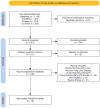Effectiveness of Omega-3 Polyunsaturated Fatty Acids in Non-alcoholic Fatty Liver Disease: A Systematic Review and Meta-Analysis
- PMID: 39347373
- PMCID: PMC11428178
- DOI: 10.7759/cureus.68002
Effectiveness of Omega-3 Polyunsaturated Fatty Acids in Non-alcoholic Fatty Liver Disease: A Systematic Review and Meta-Analysis
Abstract
Non-alcoholic fatty liver disease (NAFLD) is a prevalent liver disorder characterized by excessive hepatic fat accumulation without alcohol intake. It can progress to non-alcoholic steatohepatitis, increasing the risk of cirrhosis and liver failure. This study aims to evaluate the efficacy of omega-3 polyunsaturated fatty acids (n-3 PUFAs) in treating NAFLD. A systematic review and meta-analysis was conducted including studies published from January 2018 to June 2023. Databases searched included PubMed, Embase, Cochrane Library, and ClinicalTrials.gov. Inclusion criteria comprised randomized controlled trials and cohort studies involving human subjects or animal models with NAFLD. Data were extracted and analyzed to assess the impact of omega-3 PUFAs on liver fat, hepatic enzymes, and serum lipid profiles using RevMan 5.4. A total of 15 studies met the inclusion criteria. Omega-3 supplementation significantly decreased alanine aminotransferase (ALT) (mean difference = -2.12, 95% confidence interval (CI) = -3.36, -0.87) and aspartate aminotransferase (AST) (mean difference = -1.50, 95% CI = -2.59, -0.42). Gamma-glutamyl transferase levels showed a trend toward reduction (mean difference = -0.82, 95% CI = -1.66, 0.02). Serum lipid profiles improved significantly with reductions in triglycerides, low-density lipoprotein, and total cholesterol along with significant reductions in AST, ALT, and alkaline phosphatase in animal models. Omega-3 PUFAs appear to offer beneficial effects on liver enzymes, serum lipid profiles, and anthropometric indices in NAFLD patients. While their impact on liver fat content remains uncertain, omega-3 supplementation could serve as a valuable adjunct treatment for enhancing metabolic profiles and liver function in NAFLD patients.
Keywords: gamma-glutamyl transferase; meta-analysis; non-alcoholic fatty liver disease (nafld); non-alcoholic steatohepatitis; omega-3 polyunsaturated fatty acids.
Copyright © 2024, Aziz et al.
Conflict of interest statement
Conflicts of interest: In compliance with the ICMJE uniform disclosure form, all authors declare the following: Payment/services info: All authors have declared that no financial support was received from any organization for the submitted work. Financial relationships: All authors have declared that they have no financial relationships at present or within the previous three years with any organizations that might have an interest in the submitted work. Other relationships: All authors have declared that there are no other relationships or activities that could appear to have influenced the submitted work.
Figures






References
Publication types
LinkOut - more resources
Full Text Sources
Miscellaneous
